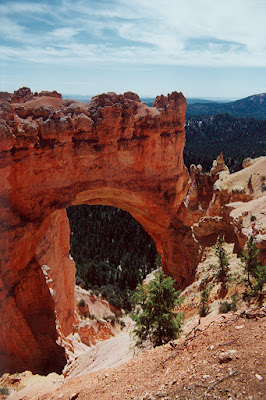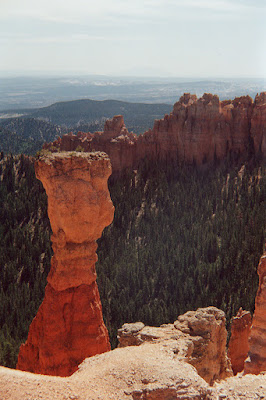A Grand Adventure 1993
Sometimes the road just calls, and in 1993 I had one of those calls. Before I started working on summer finalling franchise sports titles like hockey and basketball, I actually had the ability to take holidays during the summer months. Taking advantage of that, this summer we planned a massive looping road trip through nine of the U.S. states. Instead of camping in the National Parks of Banff and Jasper this year, we would head Southeast to Yellowstone and the Grand Canyon.
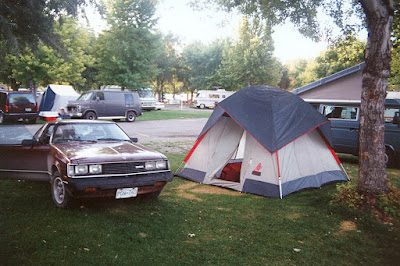
As crazy as it seems, we loaded up my 1981 Toyota Celica hatchback with camping gear, adjusted my mirrors since I couldn't see out the back window, filled up with gas and hit the road. The first leg of our trip involves a lot of driving, we wound our way through Spokane, Washington, and spent the night somewhere near the Continental Divide in either Idaho or Montana. We had been to Montana before, so it was not a memorable or photo worthy stop.
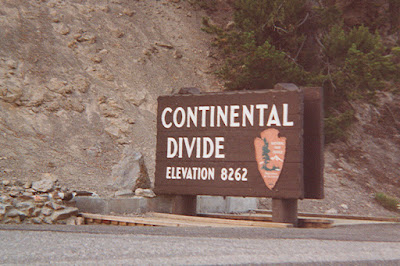
The Continental Divide is the line that divides the flow of water between the Pacific Ocean and Atlantic Ocean. Rain or snow that drains on the east side of the Continental Divide flows toward the Atlantic Ocean while on the west side it drains and flows toward the Pacific Ocean.
Yellowstone National Park, Wyoming
By the time we are looking for a campsite in Yellowstone National Park in Wyoming, I have driven for 14 hours, split into two legs. We would need to plunk down here for a few days.
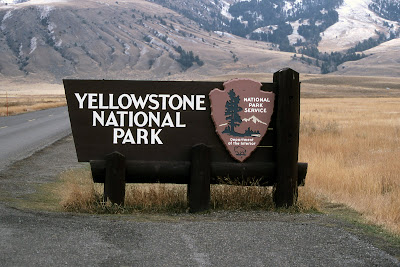
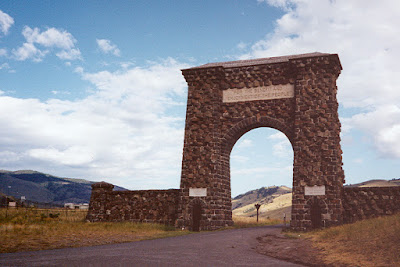
Apparently Yellowstone is the first and oldest National Park in the world, it was
designated a National park in 1872 by President Ulysses S. Grant. In 1978 it was
designated a World Heritage Site by UNESCO. It is a very unique park with it's mix of
forest, wildlife and volcanic elements such as Old Faithful. It's huge, with almost 3500
square miles of park including lakes, rivers, canyons and mountains... but mostly we came
to see wildlife and geothermal features.
It would not disappoint us on either part.
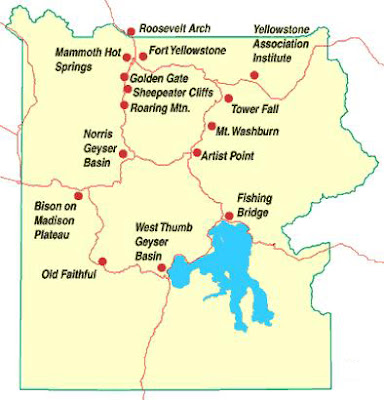
We found a campsite overlooking Yellowstone lake, nice views, but cool air. This is America's largest freshwater lake at an elevation over 8,000 feet, it's over 20 miles across. We set up our tent, cook up a camp stove dinner, and climb into our sleeping bags to stay warm. As we try to go to sleep we are serenaded by the howling of wolves. It's a little unsettling sleeping in a tent.

The next morning we are up early after a rather creepy nights sleep. We cook up a campstove breakfast and head out into the park to check out the hot springs, mud pots and other very colourful volcanic areas of the park. We drive the Grand Loop of the park, stopping a lot.

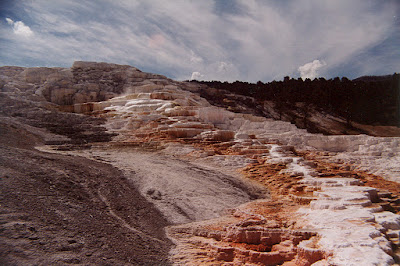
Our first stop is Mammoth Hot Springs. The springs overflow with boiling hot water full of minerals, as they flow down the slopes they create flat colourful steps over time. The areas steps can grow several inches per day. Wandering through the area is a large elk, looking for a salt lick I'm sure.
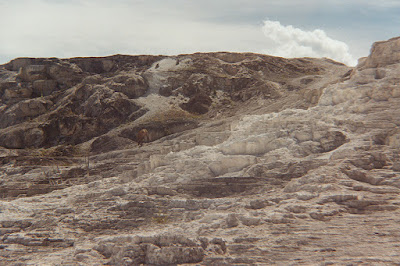

From the springs we head to Madison and the Artist Paint Pots. A half-mile hike takes us past many colorful hot springs, steam vents and bubbling mud pots. The most impressive is the Grand Prismatic Spring, an amazing sapphire blue hot water pool with bands of yellow and orange around its edges. The surrounding area is an interesting mix of red and orange steamy goodness.
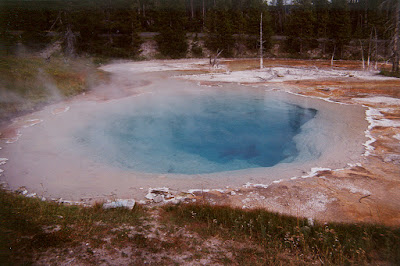
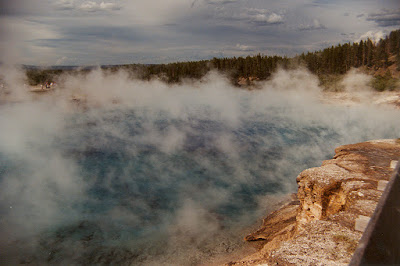
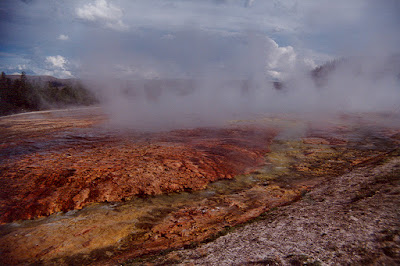
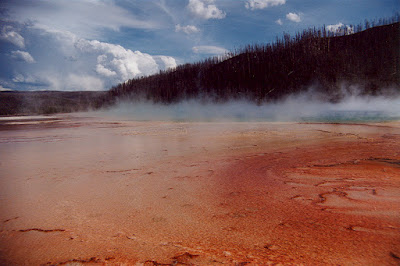
Some people say Hayden Valley is the best place to watch bison in Yellowstone, some people would be right. Hayden Valley is apparently home to a large number of animals, and includes the infamous Mud Volcano. As soon as we leave the parking area we see large Bison wandering all around the areas surrounding the pinky white Mud Volcano.
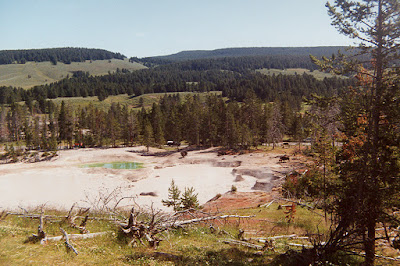
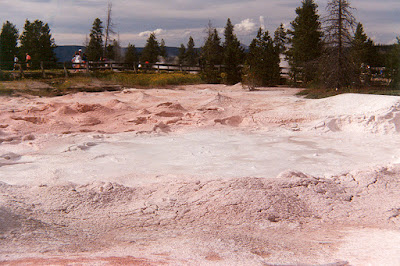

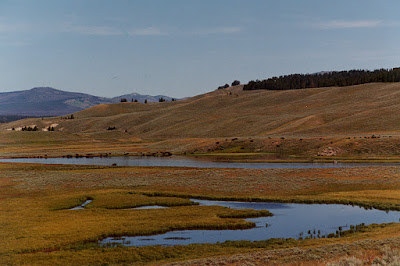
After seeing Bison (American Bison is correct, Buffalo is incorrect) all around the area from a distance, our plans for touring the Hayden Valley area had to change, they were blocking the trail. Seeing the Bison up close, and giving them their much deserved respect, was well worth missing part of this area. A nearby ranger told us stories of past visitors that got too close, and some that actually put their kids on the Bison's back to take a picture... they miss their kids.
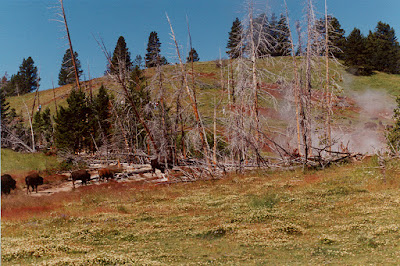

Whenever we go to a national park we hope to see some of the local wildlife. We have always been lucky in the Rocky Mountain parks of Jasper and Banff, but in Yellowstone it was amazing, there was animals everywhere. Bison at the Volcano, and a Moose and her calf wading in a river.
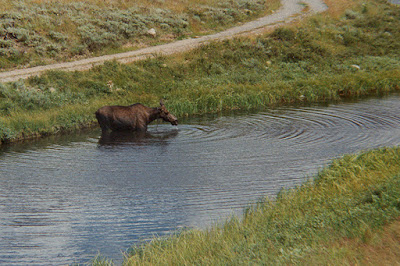
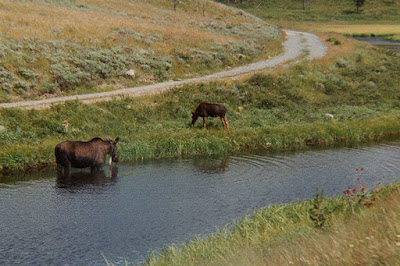
Elk were wandering everywhere, we had seen one at the Mammoth hot springs, and kept running across them as we drove the loop around the different areas of Yellowstone.


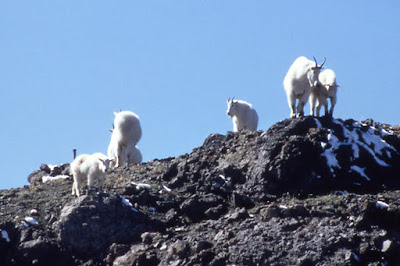
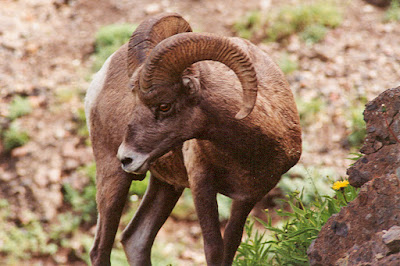
As we drive around the rockier areas of the park we spot a family of Mountain goats chewing on the rocky surface at the snow line, yes that's right, snow line. In the warmer areas are the equally sure-footed Mountain sheep with their big curly horns, the younger ones are a little more shy.
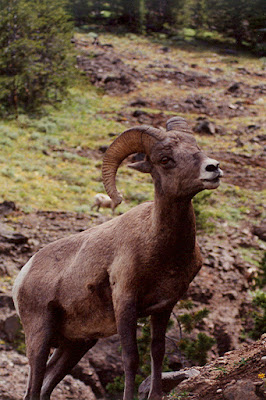

Even when we think the day is done, we have seen all the wildlife we can expect, and we are on our way back to our campsite, a coyote ignores the traffic and cuts across the road in front of us.
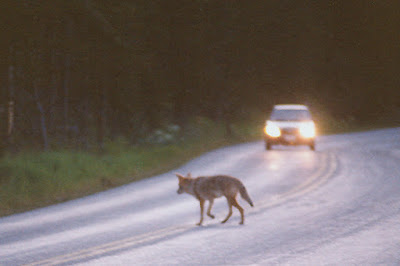
Although the warning signs were everywhere, we didn't see any bears, Grizzly or Black. Things have changed a lot over the years in Yellowstone, since they stopped letting people feed the bears from their cars or anywhere in the park, that's probably a good thing for humans and bears.
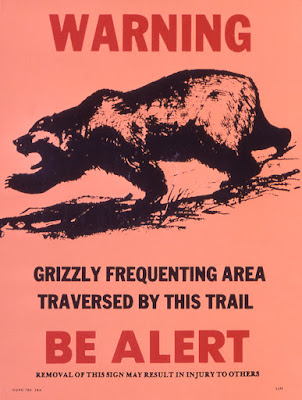
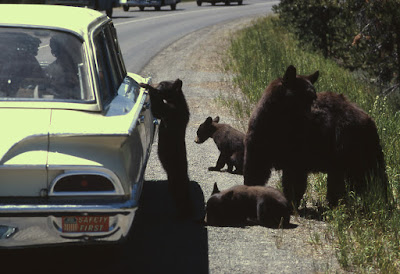
Roadside photo from 1962 in Yellowstone (note the "Safety First" bumper sticker)
After a quieter night of sleep, we were up and at 'em to check out the rest of the park. First stop... The Grand Canyon of the Yellowstone. The many different materials in the rock show up as stripes and patches of different colors in this canyon. Although not as large as the real Grand Canyon, the colourful rocks mixed with the blue river and green trees is definitely impressive.
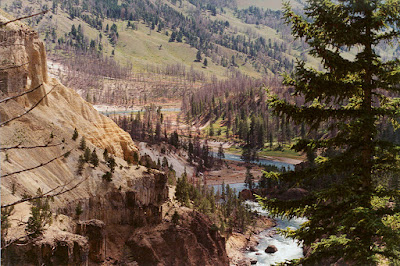
The Upper and Lower Falls of the Yellowstone are the two largest waterfalls in the park. The Upper Falls is 109 feet tall and creates a small canyon. The large Lower Falls is about 309 feet tall, and creates the Grand Canyon of the Yellowstone.
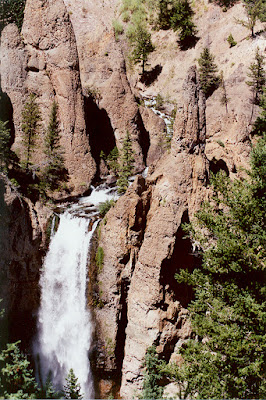

Norris Geyser Basin is one of the parks many spectacular thermal areas, and home to Steamboat Geyser. This is the world's largest geyser, and can throw water more than 300 feet into the air when it erupts. What we saw was a lot of steam, an awful lot of steam.

The Steamboat Geyser is steaming!
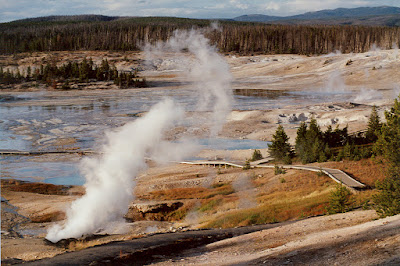

The Norris Geyser basin is a large open area full of small geysers and steaming holes, a series of boardwalks wander through the area so you can check it out. It's still a little freaky walking all around what is basically a huge volcano, but that wouldn't stop me.

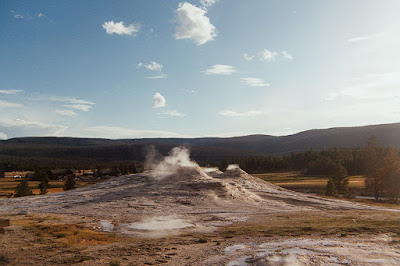
One of the small geysers was one we affectionately called the Toilet Bowl. Every 15 minutes or so, it would boil up and make a small spray, and then drain away like a toilet, very entertaining.
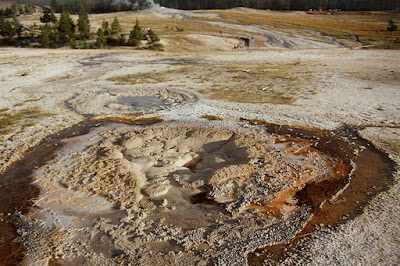

There are other geysers in Upper Geyser Basin that are well enough understood to be predictable (sort of!); Grand Geyser, Castle Geyser, Daisy Geyser, and Riverside Geyser. But nothing draws a crowd like 'Old Faithful', with it's impressive eruption every 90 minutes, just like clockwork.
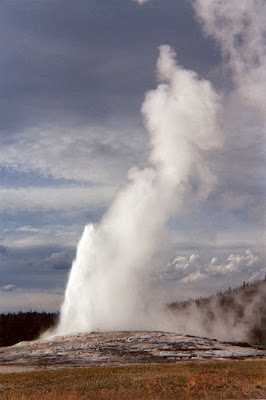
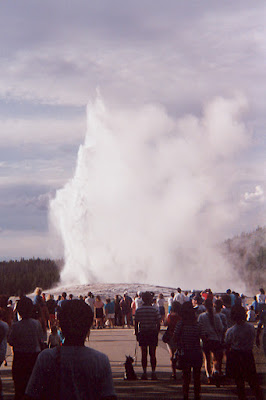
Grand Teton National Park, Wyoming
2 hours south of Yellowstone National Park is Grand Teton National Park, located in the Rocky Mountains. A majestic mountain range nestled up against a beautiful lake.
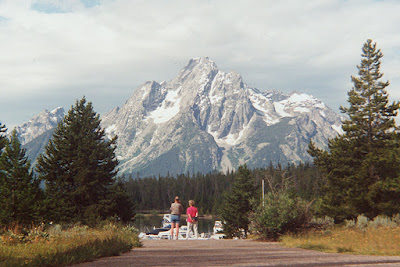
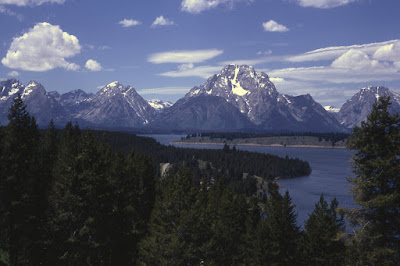
After checking out the mountains we found Colter Bay village on Jackson Lake, where they had these unique Cabin tents. A combination of 2 wood walls with a canvas enclosure, unfortunately we discovered it came with 2 fold down Bunk Beds. We couldn't keep each other warm, but at least we were off the ground. Norine was a little nervous about spiders, but spiders didn't keep us up.
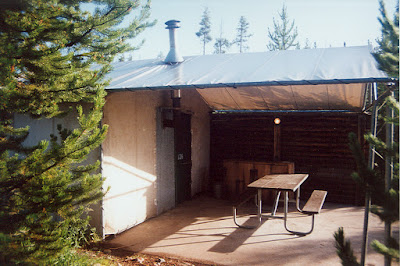
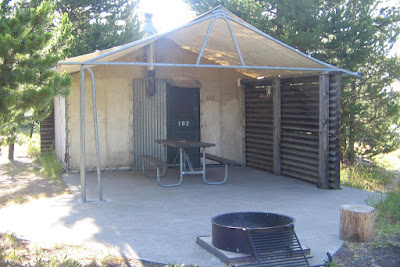
In the middle of the night we wake up to big scraping and scurrying sounds, it is pitch black in the cabin, and all kinds of thoughts start running through our heads. I grab a flashlight and nervously shine it around, 2 beady red eyes are staring back at me, and then quickly disappear in a flurry of scurry sounds. I run outside to see what it is, and spot the culprit, a Squirrel is on the loose. Every few hours he would poke his head through a hole in the canvas and check on us. Restful sleep.
Salt Lake City, Utah
From the Grand Tetons it's five hours to Salt Lake City, Utah. Salt Lake City is well-known as the center of the Church of Jesus Christ of Latter-day Saints (mormons). They have some impressive churches and structures in Temple Square at the center of downtown. We really wanted to check out the Mormon Tabernacle Choir, but not being mormons we weren't allowed into their buildings.
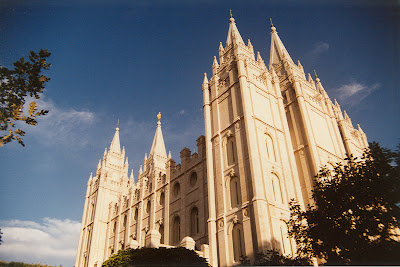

By 8:00 the town was basically shut down, stores and restaurants were closed, and the streets were empty. So we went to bed early, and got an early start on the road to Zion National Park.
Zion National Park, Utah
Zion National Park is known for its desert landscape of sandstone canyons, mesas, and high plateaus. One of the highlights of the drive is a mile-long tunnel, the Zion-Mt. Carmel Tunnel, that was completed in 1930. We are fascinated by the winding red roads created using local dirt.
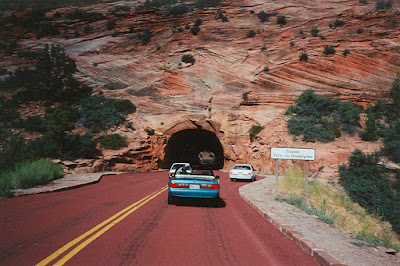
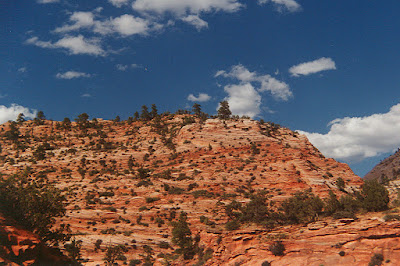
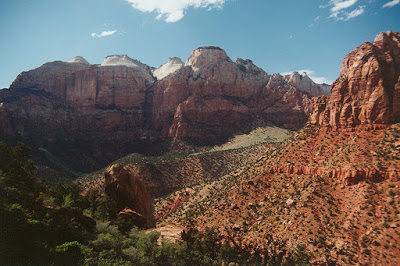

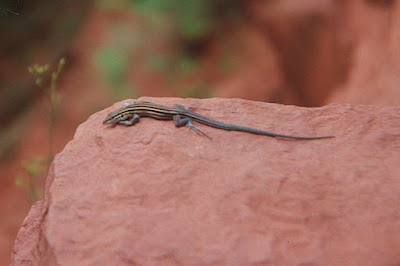
The wildlife in this park is very different, it's all snakes and lizards used to this climate.
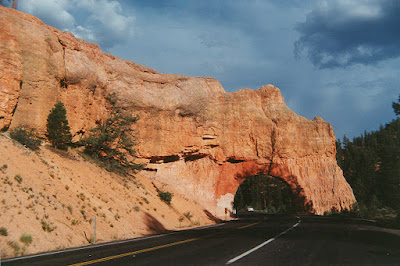
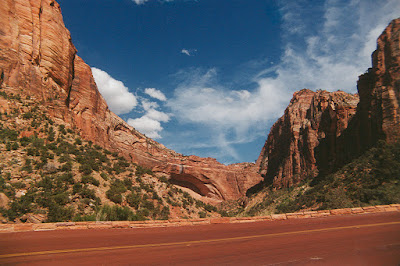
The surrounding rock area is full of amazing rock formations such as East Temple, and the Great Arch. East of the tunnel is Checkerboard Mesa, a sandstone mountain that is etched with fantastic cross-hatching of lines and shapes, made through the forces of erosion.

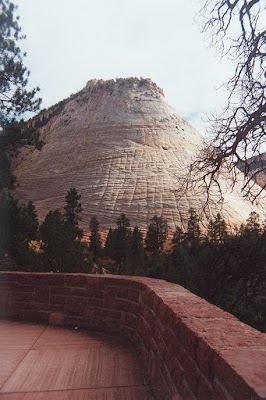
As we are driving through Zion National park we are keeping an eye open for a place to camp, but both of their campgrounds are full, so we decided to head northeast to a campsite that looks pretty good in our BCAA campbook... we had no idea what we were in for.
Bryce Canyon National Park, Utah
We ended up back tracking a bit, but it was well worth it to find the surprisingly beautiful Bryce Canyon National Park in Utah. It's not actually a canyon, but rather a giant natural amphitheater created by erosion, frost and rainwater have shaped the limestone rock into bizarre shapes including slot canyons, windows, fins, and spires called "hoodoos." The varied colors of the cliffs and rock formations contribute to the spectacular views.
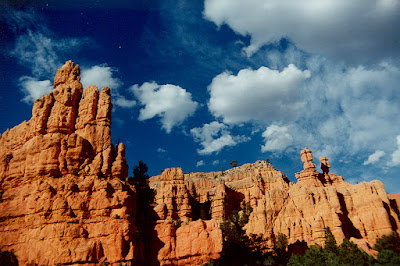
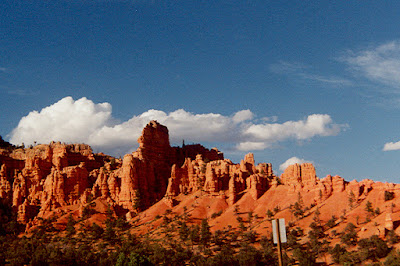
As we pull into the campground we get a glimpse of the red hoodoo shapes, but we are blown away when we hike over to the edge and look down into the amphitheater.
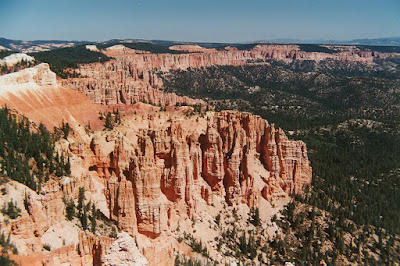
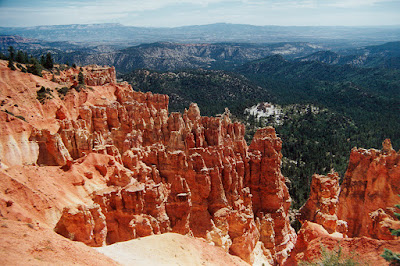
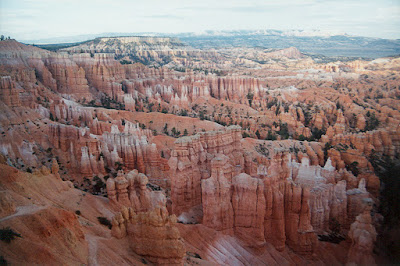
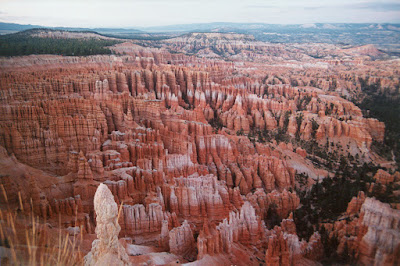
As the sun comes down over Bryce Canyon we are treated to an amazing light show. Unbeknownst to us August 11, 1993 was the Perseid Meteor shower. It is pitch black in our campground, far away from any city lights, all we have to do is lean back in our camp chairs and watch streak after streak pass through the sky. During the peak, the rate of meteors reached 60 or more per hour.
The next morning we get up early and head down into the Canyon to wander amongst the hoodoos.

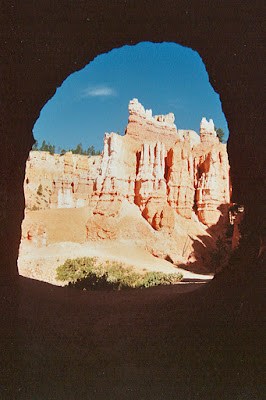

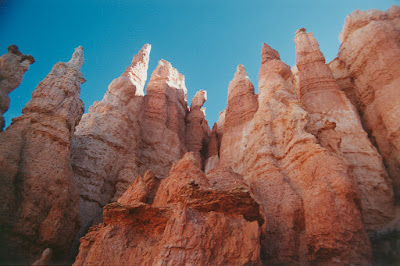
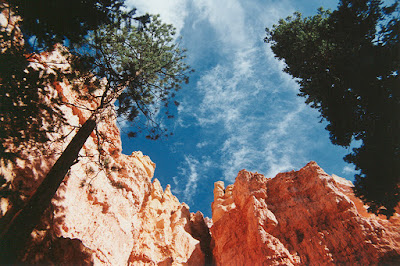
After spending the early morning admiring the hidden gardens and red hoodoos of the lower floor, we make our way back up, and prepare for the next leg of our journey... The Grand Canyon.
